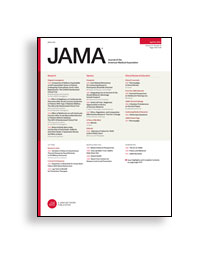JAMA Clinical Review of FM by Dr. Dan Clauw
Fibromyalgia: A Clinical Review in JAMA
 In the April 2014 Clinical Review & Education section of the Journal of the American Medical Association (JAMA), Daniel J Clauw, MD reported on advances in fibromyalgia scientific knowledge, diagnosis and treatment modalities. The hidden relevance is that since 2009 this is the only fibromyalgia article to be published in this journal. In 1987 the first JAMA fibromyalgia article, Fibromyalgia Syndrome. An Emerging but Controversial Condition by Don Goldenberg, MD was published and since then only 9 other articles on FM, including Dr. Clauw’s recent review, have been printed in this prestigious journal. The New England Journal of Medicine has published only one fibromyalgia paper, which was in 2010. That publication was a report on a study using tai chi as a treatment option for fibromyalgia. Since 1987 more than 6,000 fibromyalgia research articles have been published, but only a total of ten of them have been accepted by JAMA and one by the New England Journal of Medicine. Sadly, these publications are the two most important journals utilized by family practice doctors to keep them apprised of new developments in medicine. This is one reason why it is so difficult to find family practice doctors knowledgeable about fibromyalgia, including how to diagnose and treat it. READ MORE
In the April 2014 Clinical Review & Education section of the Journal of the American Medical Association (JAMA), Daniel J Clauw, MD reported on advances in fibromyalgia scientific knowledge, diagnosis and treatment modalities. The hidden relevance is that since 2009 this is the only fibromyalgia article to be published in this journal. In 1987 the first JAMA fibromyalgia article, Fibromyalgia Syndrome. An Emerging but Controversial Condition by Don Goldenberg, MD was published and since then only 9 other articles on FM, including Dr. Clauw’s recent review, have been printed in this prestigious journal. The New England Journal of Medicine has published only one fibromyalgia paper, which was in 2010. That publication was a report on a study using tai chi as a treatment option for fibromyalgia. Since 1987 more than 6,000 fibromyalgia research articles have been published, but only a total of ten of them have been accepted by JAMA and one by the New England Journal of Medicine. Sadly, these publications are the two most important journals utilized by family practice doctors to keep them apprised of new developments in medicine. This is one reason why it is so difficult to find family practice doctors knowledgeable about fibromyalgia, including how to diagnose and treat it. READ MOREIn his article Dr. Clauw discusses the fact that fibromyalgia is present in as much as 2% to 8% of the population, is characterized by widespread pain, and is often accompanied by fatigue, memory problems and sleep disturbances. The article’s objective is to review the epidemiology, pathophysiology, diagnosis, and treatment of fibromyalgia in order to educate healthcare professionals about advances in fibromyalgia research that can help physicians develop better fibromyalgia diagnostic skills and more successful treatment modalities. In his review Dr. Clauw discusses the numerous treatments that are available for managing fibromyalgia which are supported by high-quality scientific evidence. These include nonpharmacological therapies, including patient education, exercise, and cognitive behavioral therapy and pharmacological therapies such as tricyclics, serotonin norepinephrine reuptake inhibitors, and gabapentinoids.
Expanding on current scientific thought regarding the type of pain experienced by people with fibromyalgia, Dr. Clauw said:
 “Fibromyalgia can be thought of as a centralized pain state. Centralized pain is a lifelong disorder beginning in adolescence or young adulthood manifested by pain experienced in different body regions at different times. Centralized refers to central nervous system origins of/or amplification of pain. This term does not imply that peripheral nociceptive input (i.e. damage or inflammation of body regions) is not contributing to these individuals’ pain but rather that they feel more pain than would normally be expected based on the degree of nociceptive input. Understanding centralized pain is important for surgeons and proceduralists because patients with these disorders may request interventions to eliminate pain (eg. Hysterectomy, back surgery). Not surprisingly, this pain-prone phenotype, best exemplified by a patient with fibromyalgia, predicts failure to respond to opioids or operations performed to reduce pain.”
“Fibromyalgia can be thought of as a centralized pain state. Centralized pain is a lifelong disorder beginning in adolescence or young adulthood manifested by pain experienced in different body regions at different times. Centralized refers to central nervous system origins of/or amplification of pain. This term does not imply that peripheral nociceptive input (i.e. damage or inflammation of body regions) is not contributing to these individuals’ pain but rather that they feel more pain than would normally be expected based on the degree of nociceptive input. Understanding centralized pain is important for surgeons and proceduralists because patients with these disorders may request interventions to eliminate pain (eg. Hysterectomy, back surgery). Not surprisingly, this pain-prone phenotype, best exemplified by a patient with fibromyalgia, predicts failure to respond to opioids or operations performed to reduce pain.”
This is exactly the information that is shared in the Paradigm Medical Communications continuing medical education program "Sharpening Fibromyalgia Diagnosis and Management Skills" that the NFMCPA helped create and that Jan Chambers took part in as a faculty member and patient advocate. You can access this entire CME program which is broken into chapters at http://www.fmcpaware.org/the-paradigm.html. We encourage you to suggest this program to your doctors to help them become better educated about advances in fibromyalgia diagnosis and treatments. “Fibromyalgia can be thought of as a centralized pain state. Centralized pain is a lifelong disorder beginning in adolescence or young adulthood manifested by pain experienced in different body regions at different times. Centralized refers to central nervous system origins of/or amplification of pain. This term does not imply that peripheral nociceptive input (i.e. damage or inflammation of body regions) is not contributing to these individuals’ pain but rather that they feel more pain than would normally be expected based on the degree of nociceptive input. Understanding centralized pain is important for surgeons and proceduralists because patients with these disorders may request interventions to eliminate pain (eg. Hysterectomy, back surgery). Not surprisingly, this pain-prone phenotype, best exemplified by a patient with fibromyalgia, predicts failure to respond to opioids or operations performed to reduce pain.”
“Fibromyalgia can be thought of as a centralized pain state. Centralized pain is a lifelong disorder beginning in adolescence or young adulthood manifested by pain experienced in different body regions at different times. Centralized refers to central nervous system origins of/or amplification of pain. This term does not imply that peripheral nociceptive input (i.e. damage or inflammation of body regions) is not contributing to these individuals’ pain but rather that they feel more pain than would normally be expected based on the degree of nociceptive input. Understanding centralized pain is important for surgeons and proceduralists because patients with these disorders may request interventions to eliminate pain (eg. Hysterectomy, back surgery). Not surprisingly, this pain-prone phenotype, best exemplified by a patient with fibromyalgia, predicts failure to respond to opioids or operations performed to reduce pain.”The progression of fibromyalgia research has been remarkable and new knowledge about centralized pain is already helping to open doors to better, more effective treatment for people with fibromyalgia. Dr. Clauw ends the article with encouraging news to physicians that effective treatment for fibromyalgia is now possible.






